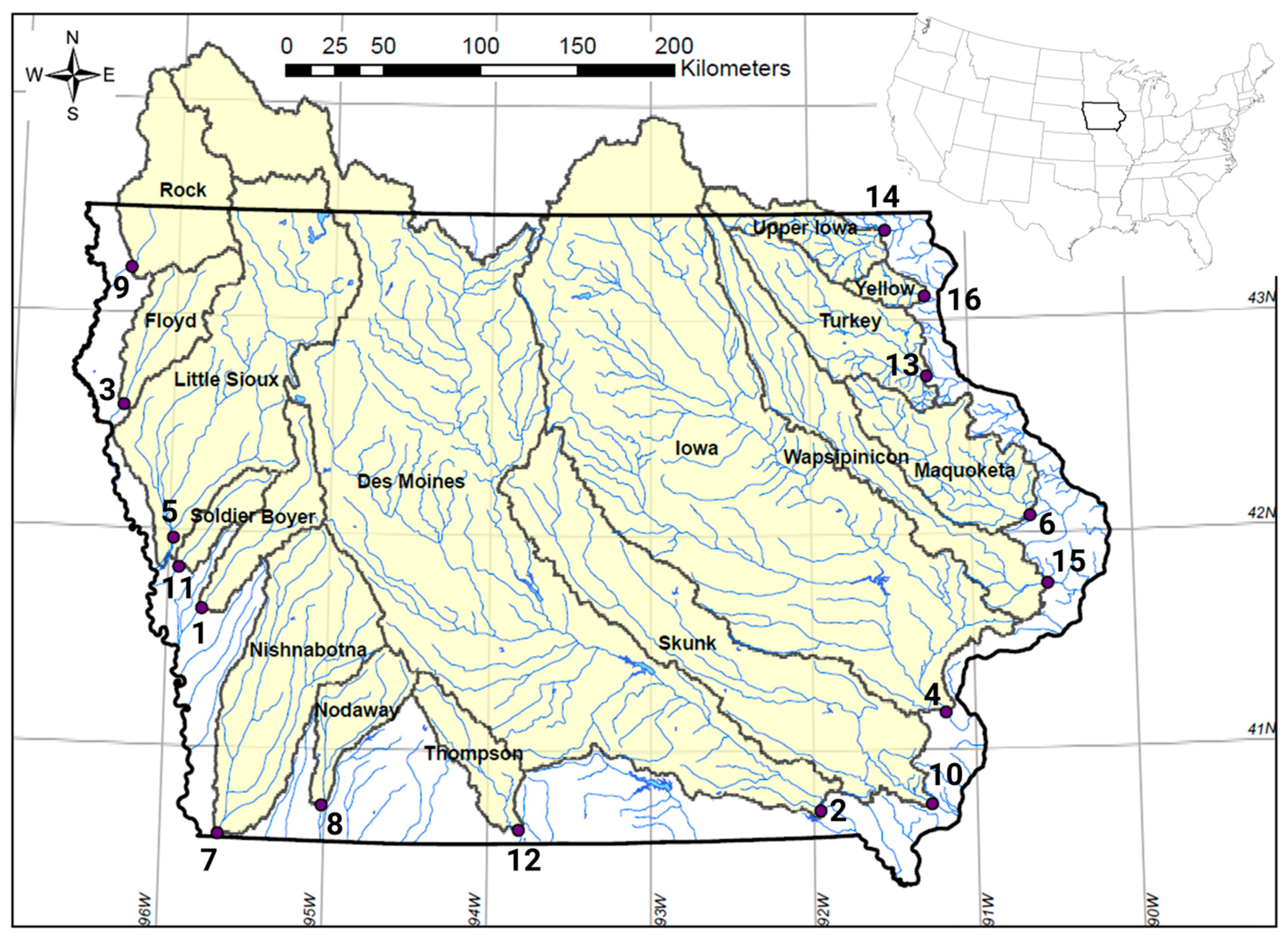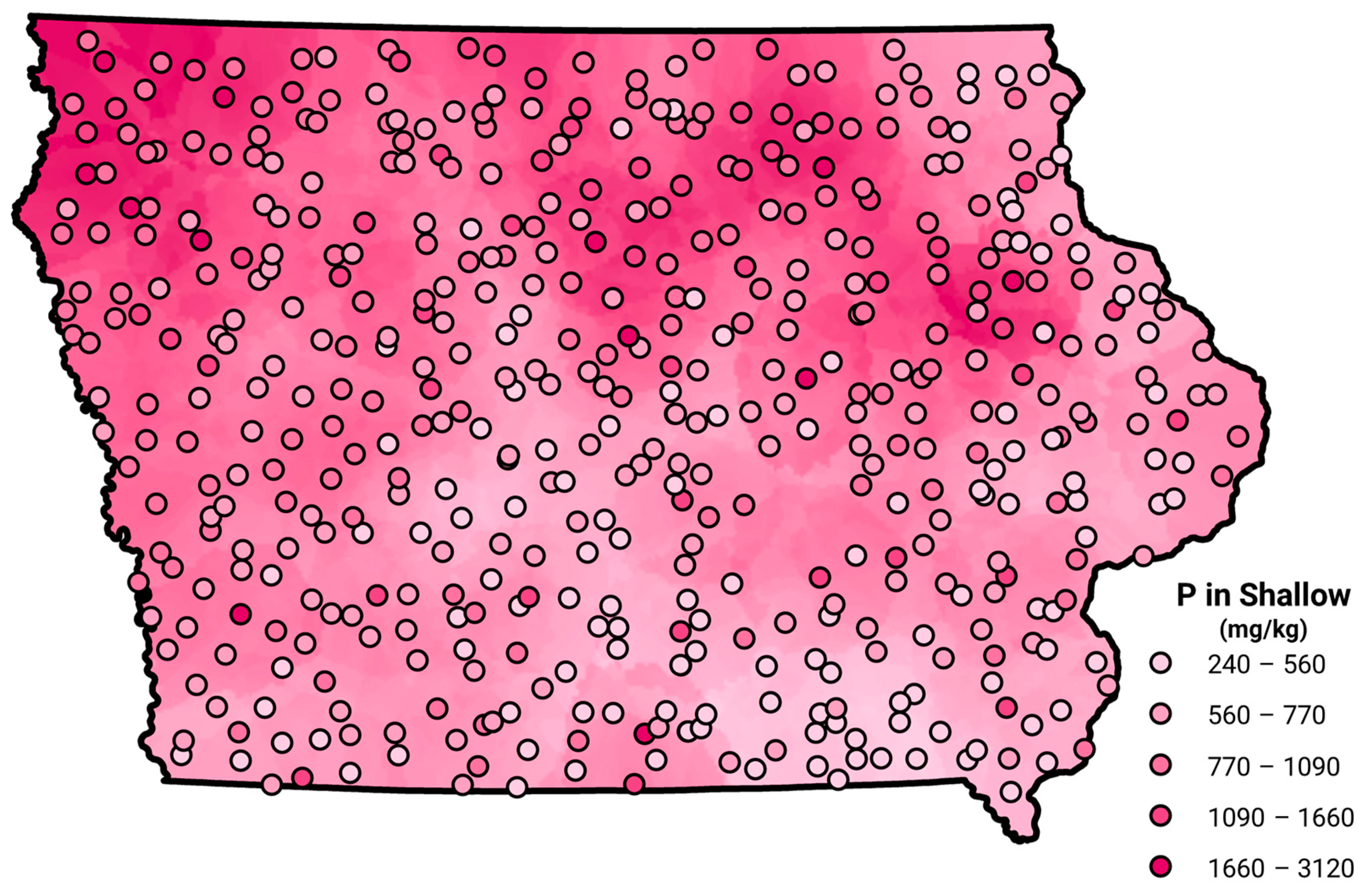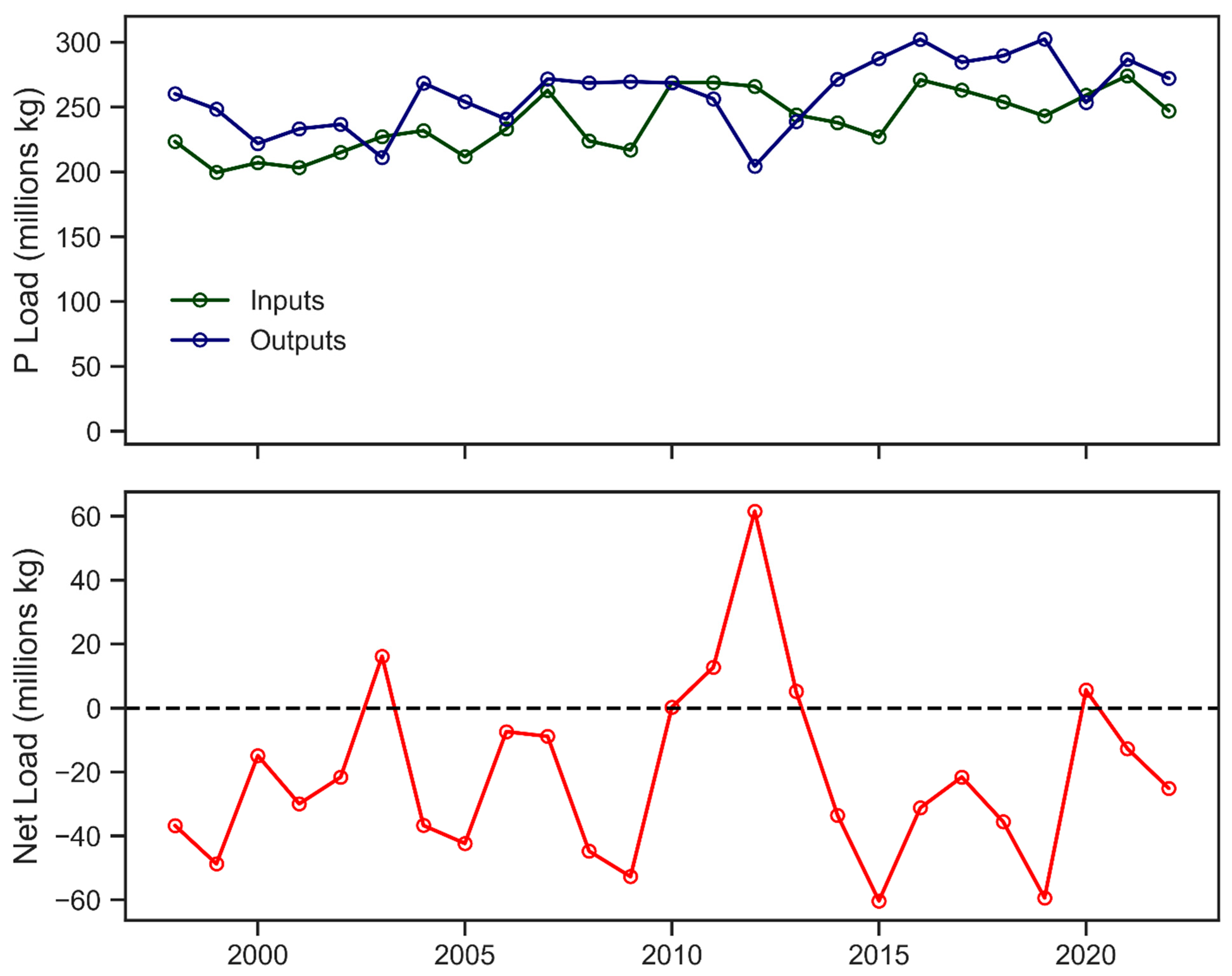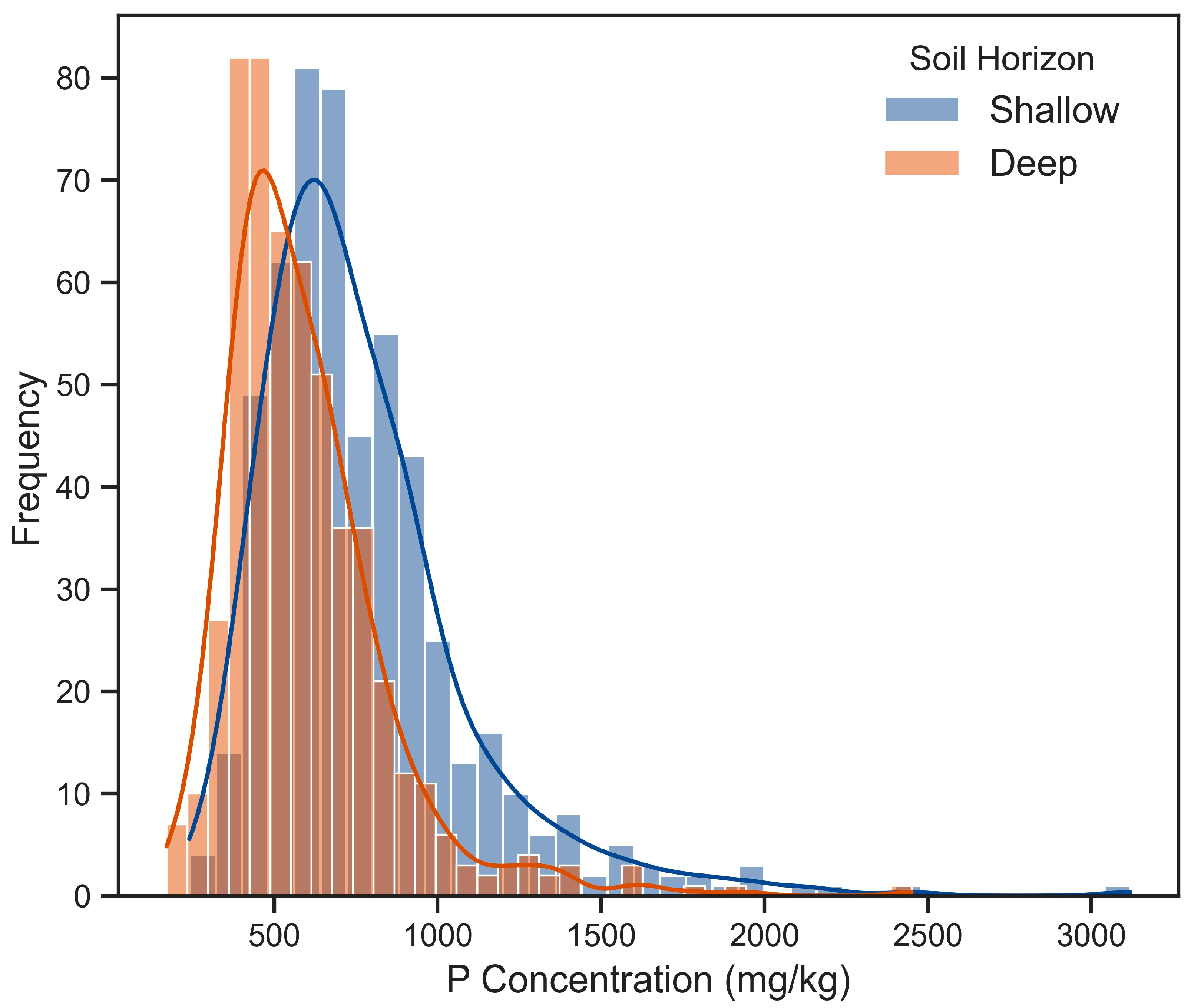Iowa’s Annual Phosphorus Budget: Quantifying the Inputs and Outputs of Phosphorus Transport Processes
Abstract
1. Introduction
2. Materials and Methods
2.1. Inputs
2.1.1. Fertilizer Application
2.1.2. Manure Production
2.1.3. Industrial Sources
2.1.4. Human Sources
2.2. Outputs
2.2.1. Harvesting
2.2.2. Livestock Grazing
2.2.3. Stream Export
2.3. Soil P Storage
2.4. Statistical Summary and Trends
3. Results
3.1. Individual Components
3.2. Overall Budget and Net P Balance
3.3. Soil Storage of P
4. Discussion
4.1. Iowa’s Net P Balance
4.2. Implications for the INRS
4.3. Budget Limitations
5. Conclusions
Supplementary Materials
Author Contributions
Funding
Data Availability Statement
Acknowledgments
Conflicts of Interest
References
- Turner, R.E.; Rabalais, N.N.; Justic, D. Gulf of Mexico hypoxia: Alternate states and a legacy. Environ. Sci. Technol. 2008, 42, 2323–2327. [Google Scholar] [CrossRef] [PubMed]
- Diaz, R.J. Overview of hypoxia around the world. J. Environ. Qual. 2001, 30, 275–281. [Google Scholar] [CrossRef]
- Sylvan, J.B.; Dortch, Q.; Nelson, D.M.; Brown, A.F.M.; Morrison, W.; Ammerman, J.W. Phosphorus limits phytoplankton growth on the Louisiana shelf during the period of hypoxia formation. Environ. Sci. Technol. 2006, 40, 7548–7553. [Google Scholar] [CrossRef] [PubMed]
- Kilham, P.; Hecky, R.E. Comparative ecology of marine and freshwater phytoplankton 1. Limnol. Oceanogr. 1988, 33, 776–795. [Google Scholar] [CrossRef]
- Mallarino, A.P.; Stewart, B.M.; Baker, J.L.; Downing, J.D.; Sawyer, J.E. Phosphorus indexing for cropland: Overview and basic concepts of the Iowa phosphorus index. J. Soil Water Conserv. 2002, 57, 440–447. [Google Scholar]
- Klatt, J.G.; Mallarino, A.P.; Downing, J.A.; Kopaska, J.A.; Wittry, D.J. Soil phosphorus, management practices, and their relationship to phosphorus delivery in the Iowa Clear Lake agricultural watershed. J. Environ. Qual. 2003, 32, 2140–2149. [Google Scholar] [CrossRef]
- Zilles, J.L.; Peccia, J.; Kim, M.-W.; Hung, C.-H.; Noguera, D.R. Involvement of Rhodocyclus-related organisms in phosphorus removal in full-scale wastewater treatment plants. Appl. Environ. Microbiol. 2002, 68, 2763–2769. [Google Scholar] [CrossRef]
- Glibert, P.M. From hogs to HABs: Impacts of industrial farming in the US on nitrogen and phosphorus and greenhouse gas pollution. Biogeochemistry 2020, 150, 139–180. [Google Scholar] [CrossRef]
- Schilling, K.; Isenhart, T.; Wolter, C.; Streeter, M.; Nouri, A.; Kovar, J. Contribution of streambanks to phosphorus export from Iowa. J. Soil Water Conserv. 2021, 77, 103–112. [Google Scholar] [CrossRef]
- Moustakidis, I.; Schilling, K.; Weber, L. Soil total phosphorus deposition and variability patterns across the floodplains of an Iowa river. CATENA 2018, 174, 84–94. [Google Scholar] [CrossRef]
- Riskin, S.H.; Porder, S.; Schipanski, M.E.; Bennett, E.M.; Neill, C. Regional differences in phosphorus budgets in intensive soybean agriculture. BioScience 2013, 63, 49–54. [Google Scholar] [CrossRef]
- Vadas, P.A.; Good, L.W.; Moore, P.A.; Widman, N. Estimating phosphorus loss in runoff from manure and fertilizer for a phosphorus loss quantification tool. J. Environ. Qual. 2009, 38, 1645–1653. [Google Scholar] [CrossRef] [PubMed]
- Wang, C.; Chan, K.; Schilling, K.E. Total phosphorus concentration trends in 40 Iowa rivers, 1999 to 2013. J. Environ. Qual. 2016, 45, 1351–1358. [Google Scholar] [CrossRef] [PubMed]
- Tomer; Moorman, T.; Kovar, J.; Cole, K.; Nichols, D. Eleven years of runoff and phosphorus losses from two fields with and without manure application, Iowa, USA. Agric. Water Manag. 2016, 168, 104–111. [Google Scholar] [CrossRef]
- Zaimes, G.N.; Schultz, R.C.; Isenhart, T.M. Streambank Soil and Phosphorus Losses Under Different Riparian Land-Uses in Iowa 1. JAWRA J. Am. Water Resour. Assoc. 2008, 44, 935–947. [Google Scholar] [CrossRef]
- Vitousek, P.M.; Porder, S.; Houlton, B.Z.; Chadwick, O.A. Terrestrial phosphorus limitation: Mechanisms, implications, and nitrogen–phosphorus interactions. Ecol. Appl. 2010, 20, 5–15. [Google Scholar] [CrossRef]
- Peñuelas, J.; Poulter, B.; Sardans, J.; Ciais, P.; Van Der Velde, M.; Bopp, L.; Boucher, O.; Godderis, Y.; Hinsinger, P.; Llusia, J.; et al. Human-induced nitrogen–phosphorus imbalances alter natural and managed ecosystems across the globe. Nat. Commun. 2013, 4, 2934. [Google Scholar] [CrossRef]
- Dodds, W.K.; Smith, V.H. Nitrogen, phosphorus, and eutrophication in streams. Inland Waters 2016, 6, 155–164. [Google Scholar] [CrossRef]
- Scholz, R.W.; Ulrich, A.E.; Eilittä, M.; Roy, A. Sustainable use of phosphorus: A finite resource. Sci. Total Environ. 2013, 461–462, 799–803. [Google Scholar] [CrossRef]
- Mayer, B.K.; Baker, L.A.; Boyer, T.H.; Drechsel, P.; Gifford, M.; Hanjra, M.A.; Parameswaran, P.; Stoltzfus, J.; Westerhoff, P.; Rittmann, B.E. Total Value of Phosphorus Recovery. Environ. Sci. Technol. 2016, 50, 6606–6620. [Google Scholar] [CrossRef]
- Cordell, D.; White, S. Peak phosphorus: Clarifying the key issues of a vigorous debate about long-term phosphorus security. Sustainability 2011, 3, 2027–2049. [Google Scholar] [CrossRef]
- Cordell, D.; White, S. Sustainable phosphorus measures: Strategies and technologies for achieving phosphorus security. Agronomy 2013, 3, 86–116. [Google Scholar] [CrossRef]
- Lewis, W.M., Jr.; Wurtsbaugh, W.A.; Paerl, H.W. Rationale for control of anthropogenic nitrogen and phosphorus to reduce eutrophication of inland waters. Environ. Sci. Technol. 2011, 45, 10300–10305. [Google Scholar] [CrossRef]
- Schindler, D.W.; Carpenter, S.R.; Chapra, S.C.; Hecky, R.E.; Orihel, D.M. Reducing phosphorus to curb lake eutrophication is a success. Environ. Sci. Technol. 2016, 50, 8923–8929. [Google Scholar] [CrossRef]
- Brown, P.W.; Schulte, L.A. Agricultural landscape change (1937–2002) in three townships in Iowa, USA. Landsc. Urban Plan. 2011, 100, 202–212. [Google Scholar] [CrossRef]
- Schilling, K.E.; Chan, K.-S.; Liu, H.; Zhang, Y.-K. Quantifying the effect of land use land cover change on increasing discharge in the Upper Mississippi River. J. Hydrol. 2010, 387, 343–345. [Google Scholar] [CrossRef]
- Oehl, F.; Oberson, A.; Tagmann, H.; Besson, J.; Dubois, D.; Mäder, P.; Roth, H.-R.; Frossard, E. Phosphorus budget and phosphorus availability in soils under organic and conventional farming. Nutr. Cycl. Agroecosyst. 2002, 62, 25–35. [Google Scholar] [CrossRef]
- Bennett, E.M.; Reed-Andersen, T.; Houser, J.N.; Gabriel, J.R.; Carpenter, S.R. A phosphorus budget for the Lake Mendota watershed. Ecosystems 1999, 2, 69–75. [Google Scholar] [CrossRef]
- Libra, R.D.; Wolter, C.F.; Langel, R.J. Nitrogen and Phosphorus Budgets for Iowa and Iowa Watersheds; Iowa Department of Natural Resources, Geological Survey: Iowa City, IA, USA, 2004. [Google Scholar]
- Goolsby, D.A.; Battaglin, W.A.; Lawrence, G.B.; Artz, R.S.; Aulenbach, B.T.; Hooper, R.; PStensland, G.J. Flux and Sources of Nutrients in the Mississippi-Atchafalaya River Basin; National Oceanic and Atmospheric Administration National Ocean Service: Silver Spring, MD, USA, 1999. [Google Scholar]
- Zhang, X.; Davidson, E.A.; Zou, T.; Lassaletta, L.; Quan, Z.; Li, T.; Zhang, W. Quantifying nutrient budgets for sustainable nutrient management. Glob. Biogeochem. Cycles 2020, 34, e2018GB006060. [Google Scholar] [CrossRef]
- Rogus, S.; Dimitri, C. Agriculture in urban and peri-urban areas in the United States: Highlights from the Census of Agriculture. Renew. Agric. Food Syst. 2014, 30, 64–78. [Google Scholar] [CrossRef]
- Lark, T.J.; Schelly, I.H.; Gibbs, H.K. Gibbs, Accuracy, bias, and improvements in mapping crops and cropland across the United States using the USDA cropland data layer. Remote. Sens. 2021, 13, 968. [Google Scholar] [CrossRef]
- Xia, Y.; Kwon, H.; Wander, M. Developing county-level data of nitrogen fertilizer and manure inputs for corn production in the United States. J. Clean. Prod. 2021, 309, 126957. [Google Scholar] [CrossRef]
- Parry, R. Agricultural phosphorus and water quality: A US Environmental Protection Agency perspective. J. Environ. Qual. 1998, 27, 258–261. [Google Scholar] [CrossRef]
- Panagos, P.; Köningner, J.; Ballabio, C.; Liakos, L.; Muntwyler, A.; Borrelli, P.; Lugato, E. Improving the phosphorus budget of European agricultural soils. Sci. Total Environ. 2022, 853, 158706. [Google Scholar] [CrossRef]
- Jones, C.S.; Nielsen, J.K.; Schilling, K.E.; Weber, L.J. Iowa stream nitrate and the Gulf of Mexico. PLoS ONE 2018, 13, e0195930. [Google Scholar] [CrossRef]
- Baker, D.B.; Richards, R.P. Phosphorus budgets and riverine phosphorus export in northwestern Ohio watersheds. J. Environ. Qual. 2002, 31, 96–108. [Google Scholar] [CrossRef]
- Titlyanova, A.A. Nutrient budget in ecosystems. Eurasian Soil Sci. 2007, 40, 1270–1278. [Google Scholar] [CrossRef]
- Iowa Department of Agriculture & Land Stewardship. Fertilizer Tonnage Distribution in Iowa; Iowa Department of Agriculture & Land Stewardship: Des Moines, IA, USA, 2021. [Google Scholar]
- National Agricultural Statistics Service. NASS—Quick Stats; USDA National Agricultural Statistics Service, United States Department of Agriculture: Washington, DC, USA, 2017. [Google Scholar]
- Lorimor, J.; Powers, W.; Sutton, A. Manure Characteristics, MWPS-18; MidWest Plan Service, Iowa State University: Ames, IA, USA, 2004. [Google Scholar]
- Mamo, M.; Ginting, D.; Zanner, C.W.; McCallister, D.L.; Renken, R.R.; Shapiro, C.A. Phosphorus stratification and potential for runoff loss following long term manure application. J. Soil Water Conserv. 2005, 60, 243–250. [Google Scholar]
- Canale, R.P.; Redder, T.; Swiecki, W.; Whelan, G. Phosphorus budget and remediation plan for Big Platte Lake, Michigan. J. Water Resour. Plan. Manag. 2010, 136, 576–586. [Google Scholar] [CrossRef]
- Sattayatewa, C.; Arnaldos, M.; Pagilla, K. Measurement of organic nitrogen and phosphorus fractions at very low concentrations in wastewater effluents. Water Environ. Res. 2011, 83, 675–683. [Google Scholar] [CrossRef]
- McCoy, M.; Schnieders, A.; Mack, L.; Cswercko, C.; Hieb, W. Nitrogen and Phosphorus Load Estimates from Iowa Point Sources during the 1980–96 Hypoxia Task Force Baseline Period; Iowa Department of Natural Resources: Des Moines, IA, USA, 2018. [Google Scholar]
- Mississippi River/Gulf of Mexico Watershed Nutrient Task Force, Gulf Hypoxia Action Plan 2008 [Electronic Resource]: For Reducing Mitigating, and Controlling Hypoxia in the Northern Gulf of Mexico and Improving Water Quality in the Mississippi River Basin; Mississippi River/Gulf of Mexico Watershed Nutrient Task Force, Ed.; United States Environmental Protection Agency, Office of Wetlands and Watersheds, U.S. Environmental Protection Agency, Office of Wetlands, Oceans, and Watersheds: Washington, DC, USA, 2018. [Google Scholar]
- Stern, A.J.; Doraiswamy, P.C.; Hunt, E.R., Jr. Changes of crop rotation in Iowa determined from the United States Department of Agriculture, National Agricultural Statistics Service cropland data layer product. J. Appl. Remote Sens. 2012, 6, 063590. [Google Scholar] [CrossRef]
- Mallarino, A.; Sawyer, J.; SK, B. General Guide for Crop Nutrient Recommendations in Iowa; Publ. PM 1688 (Rev.); Iowa State University Extension: Ames, IA, USA, 2013. [Google Scholar]
- Iowa Department of Natural Resources. Stream Water Quality Summary 2016; Iowa Department of Natural Resources: Iowa City, IA, USA, 2016. [Google Scholar]
- Kalkhoff, S.J. Transport of Nitrogen and Phosphorus in the Cedar River Basin, Iowa and Minnesota, 2000–15; US Geological Survey: Menlo Park, CA, USA, 2018. [Google Scholar]
- Hirsch, R.M.; Moyer, D.L.; Archfield, S.A. Weighted regressions on time, discharge, and season (WRTDS), with an application to chesapeake bay river inputs. J. Am. Water Resour. Assoc. 2010, 46, 857–880. [Google Scholar] [CrossRef] [PubMed]
- Zhang, Q.; Hirsch, R.M. River Water-Quality Concentration and Flux Estimation Can be Improved by Accounting for Serial Correlation Through an Autoregressive Model. Water Resour. Res. 2019, 55, 9705–9723. [Google Scholar] [CrossRef]
- Rowden, R. The Iowa State-Wide Trace Element Soil Sampling Project: Design and Implementation; Open File Report 10-1; Iowa Department of Natural Resources, Iowa Geological and Water Survey: Des Moines, IA, USA, 2010. [Google Scholar]
- United States Department of Agriculture. Soil Bulk Density/Moisture/Aeration; Natural Resources Conservation Service, Ed.; United States Department of Agriculture: Washington, DC, USA, 2019. [Google Scholar]
- Ha, M.; Wu, M. Land management strategies for improving water quality in biomass production under changing climate. Environ. Res. Lett. 2017, 12, 034015. [Google Scholar] [CrossRef]
- Han, H.; Bosch, N.; Allan, J.D. Spatial and temporal variation in phosphorus budgets for 24 watersheds in the Lake Erie and Lake Michigan basins. Biogeochemistry 2010, 102, 45–58. [Google Scholar] [CrossRef]
- Reimer, M.; Hartmann, T.E.; Oelofse, M.; Magid, J.; Bünemann, E.K.; Möller, K. Reliance on biological nitrogen fixation depletes soil phosphorus and potassium reserves. Nutr. Cycl. Agroecosyst. 2020, 118, 273–291. [Google Scholar] [CrossRef]
- MacDonald, G.K.; Bennett, E.M.; Potter, P.A.; Ramankutty, N. Agronomic phosphorus imbalances across the world’s croplands. Proc. Natl. Acad. Sci. USA 2011, 108, 3086–3091. [Google Scholar] [CrossRef]
- Sharpley, A.; Jarvie, H.P.; Buda, A.; May, L.; Spears, B.; Kleinman, P. Phosphorus Legacy: Overcoming the Effects of Past Management Practices to Mitigate Future Water Quality Impairment. J. Environ. Qual. 2013, 42, 1308–1326. [Google Scholar] [CrossRef] [PubMed]
- Zhu, J.; Li, M.; Whelan, M. Phosphorus activators contribute to legacy phosphorus availability in agricultural soils: A review. Sci. Total Environ. 2018, 612, 522–537. [Google Scholar] [CrossRef]
- Helmers, M.J. Nutrient Reduction Strategy: One Farm, Many Practices. 2013. Available online: https://www.nutrientstrategy.iastate.edu/documents (accessed on 9 September 2023).
- Schilling, K.E.; Kim, S.-W.; Jones, C.S. Use of water quality surrogates to estimate total phosphorus concentrations in Iowa rivers. J. Hydrol. Reg. Stud. 2017, 12, 111–121. [Google Scholar] [CrossRef]
- Poffenbarger, H.J.; Sawyer, J.E.; Barker, D.W.; Olk, D.C.; Six, J.; Castellano, M.J. Legacy effects of long-term nitrogen fertilizer application on the fate of nitrogen fertilizer inputs in continuous maize. Agric. Ecosyst. Environ. 2018, 265, 544–555. [Google Scholar] [CrossRef]
- Jackson, L.L.; Keeney, D.R.; Gilbert, E.M. Swine manure management plans in north-central Iowa: Nutrient loading and policy implications. J. Soil Water Conserv. 2000, 55, 205–212. [Google Scholar]
- Hashemi, F.; Olesen, J.E.; Dalgaard, T.; Børgesen, C.D. Review of scenario analyses to reduce agricultural nitrogen and phosphorus loading to the aquatic environment. Sci. Total. Environ. 2016, 573, 608–626. [Google Scholar] [CrossRef] [PubMed]
- El-Khoury, A.; Seidou, O.; Lapen, D.; Que, Z.; Mohammadian, M.; Sunohara, M.; Bahram, D. Combined impacts of future climate and land use changes on discharge, nitrogen and phosphorus loads for a Canadian river basin. J. Environ. Manag. 2015, 151, 76–86. [Google Scholar] [CrossRef]
- Lee, C.J.; Hirsch, R.M.; Schwarz, G.E.; Holtschlag, D.J.; Preston, S.D.; Crawford, C.G.; Vecchia, A.V. An evaluation of methods for estimating decadal stream loads. J. Hydrol. 2016, 542, 185–203. [Google Scholar] [CrossRef]
- Rowland, F.E.; Stow, C.A.; Johnson, L.T.; Hirsch, R.M. Lake Erie tributary nutrient trend evaluation: Normalizing concentrations and loads to reduce flow variability. Ecol. Indic. 2021, 125, 107601. [Google Scholar] [CrossRef]
- Fleming, R.A.; Babcock, B.A.; Wang, E. Resource or waste? The economics of swine manure storage and management. Appl. Econ. Perspect. Policy 1998, 20, 96–113. [Google Scholar] [CrossRef][Green Version]
- Margenot, A.J.; Kitt, D.; Gramig, B.M.; Berkshire, T.B.; Chatterjee, N.; Hertzberger, A.J.; Aguiar, S.; Furneaux, A.; Sharma, N.; Cusick, R.D. Toward a regional phosphorus (re) cycle in the US Midwest. J. Environ. Qual. 2019, 48, 1397–1413. [Google Scholar] [CrossRef]
- Cong, W.-F.; Suriyagoda, L.D.; Lambers, H. Lambers, Tightening the phosphorus cycle through phosphorus-efficient crop genotypes. Trends Plant Sci. 2020, 25, 967–975. [Google Scholar] [CrossRef]
- Griffin, T.; Honeycutt, C.; He, Z. Changes in soil phosphorus from manure application. Soil Sci. Soc. Am. J. 2003, 67, 645–653. [Google Scholar] [CrossRef]
- Rayne, N.; Aula, L. Livestock manure and the impacts on soil health: A review. Soil Syst. 2020, 4, 64. [Google Scholar] [CrossRef]
- Potter, P.; Ramankutty, N.; Bennett, E.M.; Donner, S.D. Characterizing the spatial patterns of global fertilizer application and manure production. Earth Interact. 2010, 14, 1–22. [Google Scholar] [CrossRef]
- Oenema, O.; Kros, H.; de Vries, W. Approaches and uncertainties in nutrient budgets: Implications for nutrient management and environmental policies. Eur. J. Agron. 2003, 20, 3–16. [Google Scholar] [CrossRef]
- Lehrter, J.C.; Cebrian, J. Uncertainty propagation in an ecosystem nutrient budget. Ecol. Appl. 2010, 20, 508–524. [Google Scholar] [CrossRef]






| Site Number | Short Name | Full Name | IDNRid | USGSid | P Samples | Area (km2) | Lat | Long |
|---|---|---|---|---|---|---|---|---|
| 1 | Boyer | Boyer River at Logan, IA | 10430001 | 06609500 | 397 | 2256 | 41.64169 | −95.7823 |
| 2 | Des Moines | Des Moines River at Keosauqua, IA | 10890001 | 05490500 | 498 | 36,358 | 40.72781 | −91.9596 |
| 3 | Floyd | Floyd River at James, IA | 10750001 | 06600500 | 306 | 2295 | 42.57666 | −96.3114 |
| 4 | Iowa | Iowa River at Wapello, IA | 10580003 | 05465500 | 492 | 32,375 | 41.17809 | −91.1821 |
| 5 | Little Sioux | Little Sioux River near Turin, IA | 10670003 | 06607500 | 254 | 9132 | 41.96503 | −95.9723 |
| 6 | Maquoketa | Maquoketa River near Green Island, IA | 10490005 | 05418500 | 249 | 4022 | 42.08335 | −90.6329 |
| 7 | Nishnabotna | Nishnabotna River above Hamburg, IA | 10360003 | 06810000 | 255 | 7268 | 40.60167 | −95.645 |
| 8 | Nodaway | Nodaway River at Clarinda, IA | 10730001 | 06817000 | 274 | 1974 | 40.74328 | −95.0142 |
| 9 | Rock | Rock River near Rock Valley, IA | 10840001 | 06483500 | 276 | 4123 | 43.21443 | −96.2945 |
| 10 | Skunk | Skunk River at Augusta, IA | 10560002 | 05474000 | 262 | 11,168 | 40.75365 | −91.2771 |
| 11 | Soldier | Soldier River at Pisgah, IA | 10430002 | 06608500 | 284 | 1054 | 41.83054 | −95.9314 |
| 12 | Thompson | Thompson River at Davis City, IA | 10270001 | 06898000 | 273 | 1816 | 40.64028 | −93.8083 |
| 13 | Turkey | Turkey River at Garber, IA | 10220001 | 05412500 | 433 | 4002 | 42.73999 | −91.2618 |
| 14 | Upper Iowa | Upper Iowa River near Dorchester, IA | 10030001 | 05388250 | 284 | 1994 | 43.42108 | −91.5088 |
| 15 | Wapsipinicon | Wapsipinicon River near De Witt, IA | 10820001 | 05422000 | 412 | 6050 | 41.76697 | −90.5349 |
| 16 | Yellow | Yellow River near Ion, IA | 10030002 | 05389000 | 364 | 546 | 43.11193 | −91.2651 |
| Statistic | Fertilizer | Manure | Human | Industry | Harvest | Grazing | Streams |
|---|---|---|---|---|---|---|---|
| mean | 129.1 | 106.2 | 3.3 | 0.6 | 226.6 | 14.7 | 18.8 |
| std | 17.44 | 12.93 | 0.11 | 0.02 | 24.50 | 3.66 | 11.13 |
| min | 101 | 87.3 | 3.11 | 0.563 | 187 | 9.17 | 5.26 |
| 25% | 114 | 94.9 | 3.22 | 0.581 | 209 | 11.8 | 7.25 |
| 50% | 124 | 107 | 3.32 | 0.6 | 230 | 14.3 | 18 |
| 75% | 140 | 119 | 3.41 | 0.616 | 248 | 17 | 25.6 |
| max | 159 | 128 | 3.48 | 0.629 | 268 | 23.4 | 41.6 |
| cv | 0.14 | 0.12 | 0.03 | 0.03 | 0.11 | 0.25 | 0.59 |
| trend | no trend | increasing | increasing | increasing | increasing | decreasing | no trend |
Disclaimer/Publisher’s Note: The statements, opinions and data contained in all publications are solely those of the individual author(s) and contributor(s) and not of MDPI and/or the editor(s). MDPI and/or the editor(s) disclaim responsibility for any injury to people or property resulting from any ideas, methods, instructions or products referred to in the content. |
© 2024 by the authors. Licensee MDPI, Basel, Switzerland. This article is an open access article distributed under the terms and conditions of the Creative Commons Attribution (CC BY) license (https://creativecommons.org/licenses/by/4.0/).
Share and Cite
Anderson, E.; Schilling, K.; Jones, C.; Weber, L.; Wolter, C. Iowa’s Annual Phosphorus Budget: Quantifying the Inputs and Outputs of Phosphorus Transport Processes. Land 2024, 13, 1483. https://doi.org/10.3390/land13091483
Anderson E, Schilling K, Jones C, Weber L, Wolter C. Iowa’s Annual Phosphorus Budget: Quantifying the Inputs and Outputs of Phosphorus Transport Processes. Land. 2024; 13(9):1483. https://doi.org/10.3390/land13091483
Chicago/Turabian StyleAnderson, Elliot, Keith Schilling, Christopher Jones, Larry Weber, and Calvin Wolter. 2024. "Iowa’s Annual Phosphorus Budget: Quantifying the Inputs and Outputs of Phosphorus Transport Processes" Land 13, no. 9: 1483. https://doi.org/10.3390/land13091483
APA StyleAnderson, E., Schilling, K., Jones, C., Weber, L., & Wolter, C. (2024). Iowa’s Annual Phosphorus Budget: Quantifying the Inputs and Outputs of Phosphorus Transport Processes. Land, 13(9), 1483. https://doi.org/10.3390/land13091483





